 Open Access
Open Access
ARTICLE
Abstractive Arabic Text Summarization Using Hyperparameter Tuned Denoising Deep Neural Network
1 Department of Computer Science, College of Science and Arts, Sharurah, Najran University, Sharurah, Saudi Arabia
2 Department of Applied Linguistics, College of Languages, Princess Nourah bint Abdulrahman University, P.O. Box 84428, Riyadh, 11671, Saudi Arabia
3 Department of Information Systems, College of Computing and Information System, Umm Al-Qura University, Makkah, Saudi Arabia
4 Department of Digital Media, Faculty of Computers and Information Technology, Future University in Egypt, New Cairo, 11835, Egypt
5 Computer Department, Applied College, Najran University, Najran, 66462, Saudi Arabia
6 Department of Computer and Self Development, Preparatory Year Deanship, Prince Sattam bin Abdulaziz University, AlKharj, Saudi Arabia
* Corresponding Author: Manar Ahmed Hamza. Email:
Intelligent Automation & Soft Computing 2023, 38(2), 153-168. https://doi.org/10.32604/iasc.2023.034718
Received 25 July 2022; Accepted 11 November 2022; Issue published 05 February 2024
Abstract
Abstractive text summarization is crucial to produce summaries of natural language with basic concepts from large text documents. Despite the achievement of English language-related abstractive text summarization models, the models that support Arabic language text summarization are fewer in number. Recent abstractive Arabic summarization models encounter different issues that need to be resolved. Syntax inconsistency is a crucial issue resulting in the low-accuracy summary. A new technique has achieved remarkable outcomes by adding topic awareness in the text summarization process that guides the module by imitating human awareness. The current research article presents Abstractive Arabic Text Summarization using Hyperparameter Tuned Denoising Deep Neural Network (AATS-HTDDNN) technique. The presented AATS-HTDDNN technique aims to generate summaries of Arabic text. In the presented AATS-HTDDNN technique, the DDNN model is utilized to generate the summary. This study exploits the Chameleon Swarm Optimization (CSO) algorithm to fine-tune the hyperparameters relevant to the DDNN model since it considerably affects the summarization efficiency. This phase shows the novelty of the current study. To validate the enhanced summarization performance of the proposed AATS-HTDDNN model, a comprehensive experimental analysis was conducted. The comparison study outcomes confirmed the better performance of the AATS-HTDDNN model over other approaches.Keywords
The text summarization process can be classified into three types based on the angle of observation. The initial angle is related to the input type in which the summarization process is classified into a single- or multi-document summarization [1]. At the time of document summarization, the input becomes merely a single document, and the text from those documents is summarized. In the case of multi-document summarization, the input can be of a multi-document type, whereas the summary must contain data from every single document [2]. The second angle is related to the context-based text summarization process in which the process is classified into domain-specific, generic and query-driven summaries. Among these, generic summaries utilize only the original documents, while query-driven summaries concentrate on returning a significant amount of data based on the query raised by an end user. Domain-specific summary utilizes certain areas of concern to generate the summaries [3,4]. The final and the most significant angle of the text summarization process depends upon the types of output, which in turn have two kinds, such as abstractive and extractive summarization. In extractive summarization, the summary is generated based on the phrases or sentences in the source document by relying upon linguistic and statistical features. On the other hand, the abstractive summarization process expresses the ideologies from the source document using different words related to the real semantics of the text [5,6]. The abstractive summarization process is generally more complex than the extractive one since the former involves semantic text analysis using advanced Natural Language Processing (NLP) and ML approaches. But abstractive summarization is better in terms of quality since it produces a summary of the text, which is almost identical to a human-written summary and is more meaningful [7].
In recent times, DL approaches improved and are widely applied in significant tasks, namely, text summarization, text translation, Sentiment Analysis (SA) and other sectors. Similarly, one of the significant features of utilizing DNNs is that it takes full advantage of big datasets to improve their outcomes. Novel text summarization techniques are related to the sequence-to-sequence structure of encoder-decoder modes [8,9]. Arabic is one of the ancient languages widely spoken across the globe. In contrast, much information is yet to be revealed since archaeologists are still attempting to discover much about this language. Arabic has an official language status in 26 countries, with over 280 million speakers across the globe [10]. However, text summarization processes face difficulties, as far as the Arabic language is concerned, owing to the difficulties with morphological and syntactic structures. Further, the compression ratio is also observed when summarizing many texts instead of a single document [11]. No standard summary exists for the Arabic language, machine-readable dictionaries, or Arabic benchmark corpora or lexicons [12]. Arabic Text Summarization (ATS) has multiple challenges to deal with for research communities, such as identification of the most useful text segment in the product, summarization of numerous documents; assessment of computer-made summaries without comparing them with the summaries generated by humans [13]; and production of abstractive summaries compared with human-made ones. Across the globe, researchers are still searching for an effective ATS mechanism that can precisely review the major topics of the Arabic language [14].
In this background, the current research article presents Abstractive Arabic Text Summarization using Hyperparameter Tuned Denoising Deep Neural Network (AATS-HTDDNN) technique. The presented AATS-HTDDNN technique aims to generate summaries of Arabic text. In the presented AATS-HTDDNN technique, the DDNN model is utilised to generate summaries. Chameleon Swarm Optimization (CSO) algorithm is exploited in this study, which is also a novel contribution of the current study, to fine-tune the hyperparameters relevant to the DDNN model since it considerably affects its summarization efficiency. To validate the enhanced summarization performance of the proposed AATS-HTDDNN model, a comprehensive experimental analysis was conducted.
In literature [15], a hybrid, single-document text summarization technique (ASDKGA) was proposed integrating Genetic Algorithm (GA), domain knowledge, and statistical features for the extraction of significant points from Arabic political files. The proposed ASDKGA technique was tested on two corpora such as Essex Arabic Summaries Corpus (EASC) and KALIMAT corpus. Recall-based Understudy for Gisting Evaluation (ROUGE) structure was utilized to compare the ASDKGA-based mechanically-produced summaries with that of the summaries produced by human beings. Qaroush et al. [16] devised an automated, generic, and extractive Arabic single document summarization methodology. This method focused on generating summaries with adequate information. The formulated extractive algorithm evaluated every sentence related to the amalgamation of semantic and statistical attributes, in which a new formulation was utilized considering diversity, sentence importance, and coverage. Moreover, two summarization techniques, supervised ML and score-related, were used to generate the summaries, after which the devised features were utilized. Alami et al. [17] presented a new graph-based Arabic summarization mechanism integrating semantic and statistical analyses. The presented technique used ontology-based hierarchical structures and relationships to produce highly-precise similarity measurements among the terms to improve the summary’s quality. The presented approach relied upon a 2-dimensional graph method in which semantic and statistical similarities were deployed.
In the study conducted earlier [18], the authors attempted to overcome the existing limitations through an innovative technique utilizing unsupervised NNs, document clustering, and topic modelling to frame a potential file representation method. At first, a novel document clustering approach, using Extreme Learning Machine, was executed on a large text corpus. Secondly, topic modelling was implemented for document collection so as to identify the topics in every cluster. Thirdly, a matrix gave every document a topic space in which the columns represented cluster topics and rows denoted document sentences. In literature [19], the authors tried to overcome such limitations by implementing linear algebraic and statistic techniques integrated with the text’s semantic and syntactic processing. Then, the parts of the speech tagger were utilized to reduce LSA dimensions. Then, the term weight in four adjacent sentences was included in the weighting methods, whereas the input matrix was computed to consider syntactic relations and word orders.
Alami et al. [20] introduced an innovative technique for ATS with the help of the Variational Auto-Encoder (VAE) method to study a feature space using a higher-dimension input dataset. The authors explored input representations like Term Frequency (TF) and TF-IDF along with global and local glossaries. Every sentence was ranked under the hidden presentation generated by VAE. In literature [21], the authors accepted a pre-processing approach to resolve the noise issues and utilized the word2vec approach for two purposes; to map the words with a fixed-length vector and to obtain the semantic relations among every vector related to the dimension. Likewise, the author employed a K-means technique for two purposes: selecting distinctive files and tokenising the document into sentences. In this study, additional iterations of the k-means technique were employed to select the key sentences related to the similarity metric to overcome redundancy and produce the summary early.
The current study developed the projected AATS-HTDDNN technique for Arabic text summarization. The presented AATS-HTDDNN technique aims to generate summaries of Arabic text. In the presented AATS-HTDDNN technique, the DDNN model generates the summaries. Since the hyperparameters relevant to the DDNN model considerably affect the efficiency of the summarization process, the CSO algorithm is exploited. Fig. 1 showcases the block diagram of the proposed AATS-HTDDNN approach.
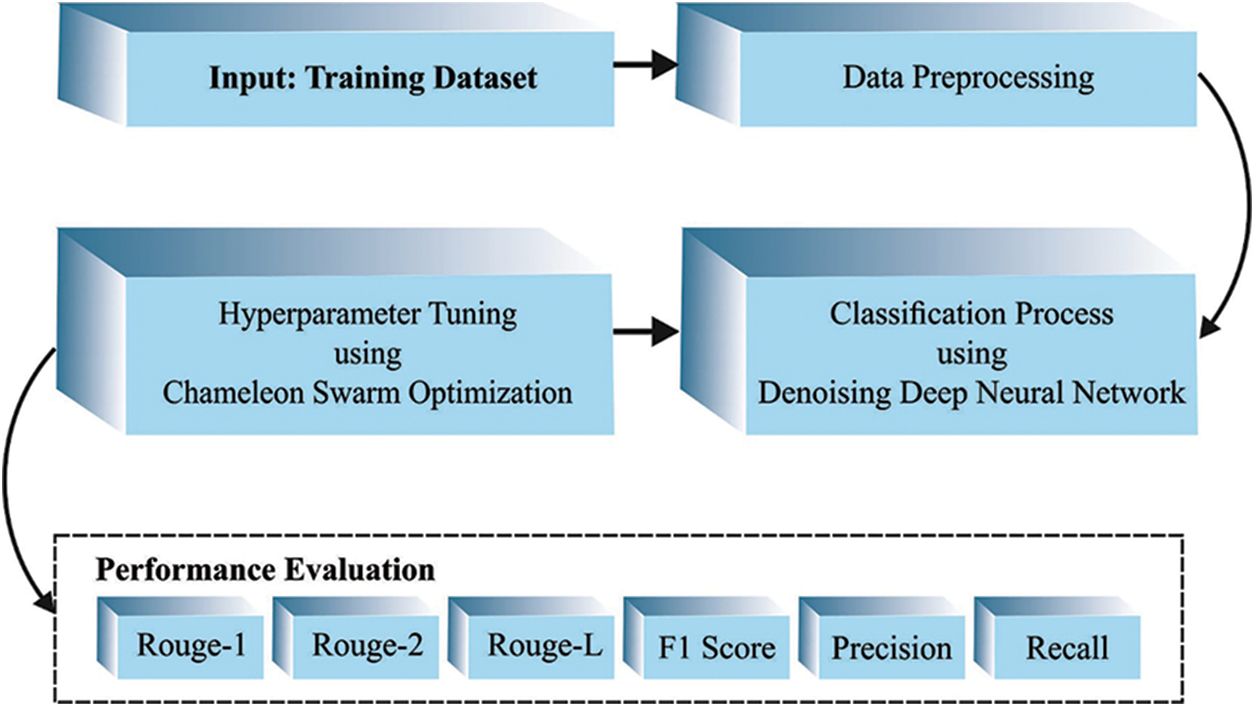
Figure 1: Block diagram of the AATS-HTDDNN approach
3.1 Text Summarization Using DDNN Model
The DDNN model is utilized in this study for the text summarization process. DDNN is created by integrating DAE and RBM and efficiently reduces the noise without removing the features. For the DDNN technique, a vector with set dimensions is considered the input value. Primarily, the technique is applied by denoising element, which has two layers named DAE1 and DAE2, with the help of unsupervised training approaches [22]. At this point, the other instance is trained all the time. Training is generally provided to minimize the reconstruction error in input data result from the preceding layer. Since the encoded or potential expression can be computed based on the preceding layer k, the
This phase is developed by stacking two RBM layers. The model is trained by training the RBM from low to high values as given below:
(1) An input of the bottom RBM denotes the resultant of the Denoising layer
(2) The features extracted from the bottom RBM are input values for the topmost RBM.
The rationale behind selecting DAE during the text classification procedure is that the data certainly exists in the form of a blend of distinct kinds. In contrast, the intensity of the noise affects the trained model and deteriorates the final classification performance. DAE performs the initial extraction of new features, whereas the learning condition is noise reduction. During pre-training, various unique strengths and distinct noise signals are added to the new input signals so that the encoded model attains the optimum stability and robustness.
DDNN technique comprises four layers such as RBM1, RBM2, DAE1, and DAE2. Here, layer v acts as either a visual or input layer for the DDNN technique. All the documents in this work are demonstrated by a set of dimensional vectors, whereas
Especially the overview of the energy model is to capture the relationship amongst the variables and augment the model parameters too. So, it is essential to embed the optimum solution problems, such as the energy function, if the model parameters are to be trained. At this point, the RBM energy function is determined as follows:
Here, Eq. (1) implies the energy functions of all the visible and hidden nodes connected to the infrastructure. Particularly, n defines the count of hidden nodes, m represents the number of visible layer nodes, and b and c signify the bias values of visual and hidden layers correspondingly. The main function of the RBM technique is to accumulate the energy of every visible and hidden node. So, all the samples need to count the value of each hidden node equivalent to it so that the total energy is computed. The computation is difficult, whereas the joint likelihood of hidden and visible nodes is given below:
By establishing these probabilities, the energy function is simplified. In other words, the solution’s objective is to mitigate the energy value. A statistical learning model exists in which the state of minimal energy has a superior probability to higher energy. Therefore, as shown below, it can maximize the probability and establish the free energy function.
So,
whereas Z demonstrates the normalization factor. Afterwards, the joint probability
The 1st term on the right side of Eq. (5) represents the negative value of the free energy function for the entire network, whereas the left entity denotes the probability function. The model parameter is resolved by utilizing the maximal possibility function estimate.
At this point, it can act as a primary function to create a denoising function element for the novel feature and is mostly collected from DAE. The 2-layer DAE is located at the bottom of the models to ensure complete utilization of the denoising characters. Here, an input signal is denoised by restructuring the input signals with unsupervised learning. Afterwards, the influence of the noise upon succeeding construction of the classification dataset gets decreased.
The secondary element is established by employing DBN, created using RBM. Then, feature extraction capability is increased in this method. In addition, this method also attains difficult principles from the data, whereas high-level feature extraction is representative. To achieve optimum sorting outcomes, the extraction representative feature is utilized as input to the final classification. Then, the extraction process is repeated again with the help of RBM. Assuming the complexity of the training process and the efficacy of models, a 2-layer DAE and a 2-layer RBM are utilized.
3.2 Parameter Tuning Using CSO Algorithm
In this study, the CSO algorithm is used to fine-tune the hyperparameters involved in the DDNN model. This algorithm considerably enhances the efficiency of the summarization process. The proposed CSA is a new metaheuristic algorithm simulated from the hunting behaviour and food searching method. Chameleons are much-specified classes of species which are capable of changing their body colour according to the environment so that it quickly blends with their environment [23]. Chameleons can live and survive in semi-desert areas, lowlands, mountains, and deserts, and usually prey upon insects. Its food hunting procedure includes the following phases namely, attacking the prey, tracking the prey, and pursuing the prey using their sight. The mathematical steps and models are described in the succeeding subsections. Fig. 2 illustrates the steps involved in the CSO technique.
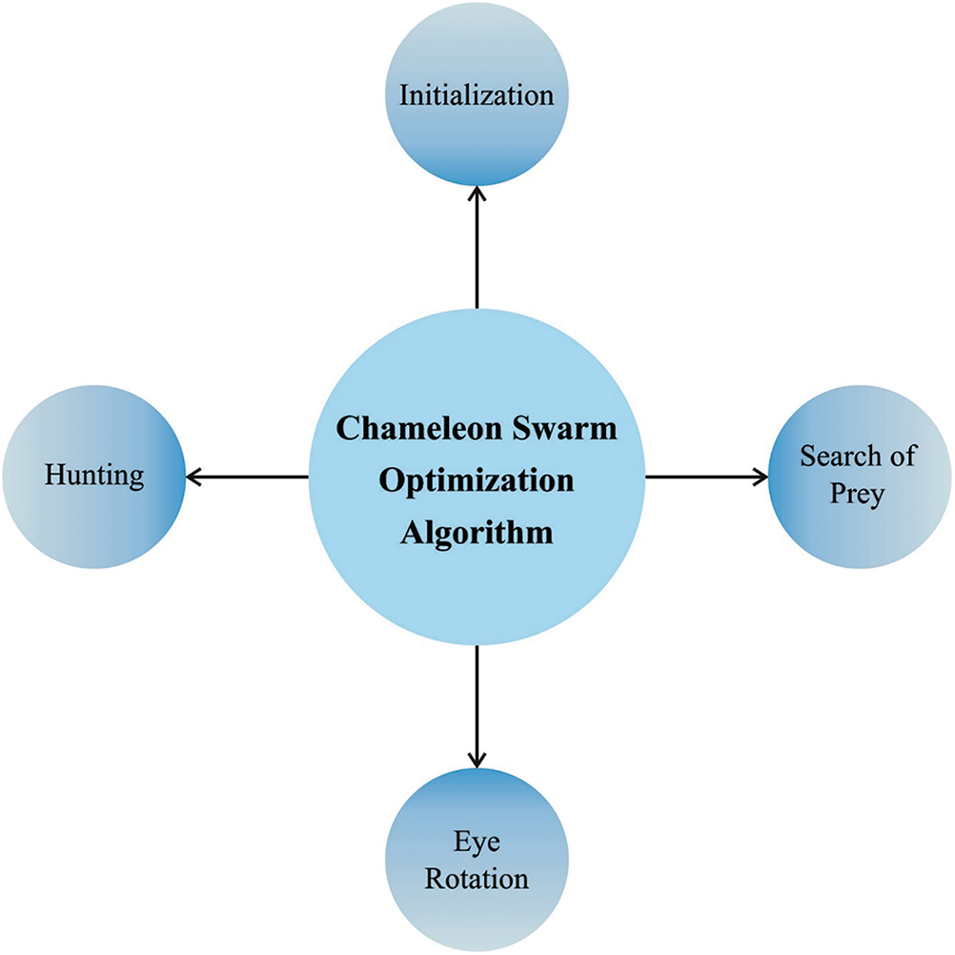
Figure 2: Steps involved in CSO technique
Initialization and Function Evaluation
CSA refers to a population-related metaheuristic algorithm that arbitrarily produces an initial population for optimization. The population of size n is produced in the d dimension search region, in which every individual in the population is a feasible solution to the optimization issue. The position of the chameleon, during iterations, in the searching region is calculated as follows:
Here,
The initial population is produced according to the problem dimension, whereas the chameleon count in the searching region is determined as follows:
In Eq. (7),
Search of Prey
The movement behaviour, at the time of searching, is represented by the updated approach of the location, as follows:
In Eq. (8), t and
Further,
Chameleon’s Eyes Rotation
Chameleons can recognize the location of the prey by rotating their eyes up to 360 degrees. This feature assists in spotting the target for which the steps are given below:
• The initial location is the focal point of gravity;
• The rotation matrix identifies the prey’s situation;
• Type equation here. The location is restored through a rotation matrix at the focal point of gravity;
• Type equation here. At last, they are resumed to the initial location position.
Hunting Prey
Chameleon assaults its target, once it is extremely closer to the target. The chameleon adjacent to the target is the optimum chameleon which is regarded as the optimum outcome. Such chameleons assault the target through its tongue. The chameleon situation gets enhanced since it can prolong its tongue up to double its length. It assists the chameleon in exploiting the pursuit space and enables it to sufficiently catch the target. The speed of the tongue, once it is protracted toward the target, is arithmetically given herewith.
In Eq. (9),
The current section provides information on the performance validation of the proposed model under different measures. Table 1 offers the detailed summarization outcomes accomplished by the proposed AATS-HTDDNN model and other existing models in terms of ROUGE.

Fig. 3 demonstrates the comparative R1 analysis results achieved by the proposed AATS-HTDDNN model and other existing models in terms of R1. The results imply that BERT-Fine Tuning and BiLSTM models reported the least R1 values such as 12.93% and 30.31%, respectively. At the same time, GRU, Seq2seq, and multilayer bi-seq2seq models achieved slightly higher R1 values, such as 55.77%, 62.13%, and 60.79%, respectively. Meanwhile, D-RNN model reached a reasonable R1 value of 71.60%. But, the proposed AATS-HTDDNN model achieved enhanced performance with a maximum R1 value of 78.35%.
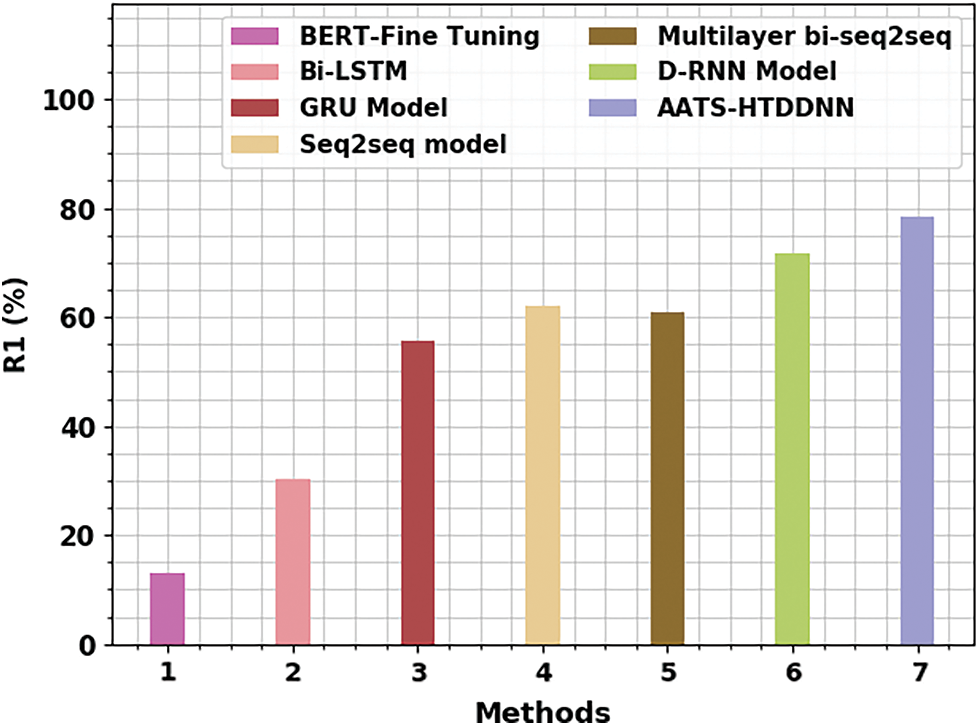
Figure 3: R1 analysis results of AATS-HTDDNN approach and other existing algorithms
Fig. 4 showcases the comparative R2 study outcomes of the proposed AATS-HTDDNN algorithm and other existing models in terms of R2. The results denote that BERT-Fine Tuning and BiLSTM approaches reported the least R2 values, such as 9.44% and 11.70% correspondingly. Meanwhile, GRU, Seq2seq, and multilayer bi-seq2seq approach achieved slightly higher R2 values such as 13.91%, 34.46%, and 41.28%, correspondingly. In the meantime, D-RNN approach attained a reasonable R2 value of 58.60%. But, the proposed AATS-HTDDNN technique exhibited enhanced performance with a maximum R2 value of 65.98%.
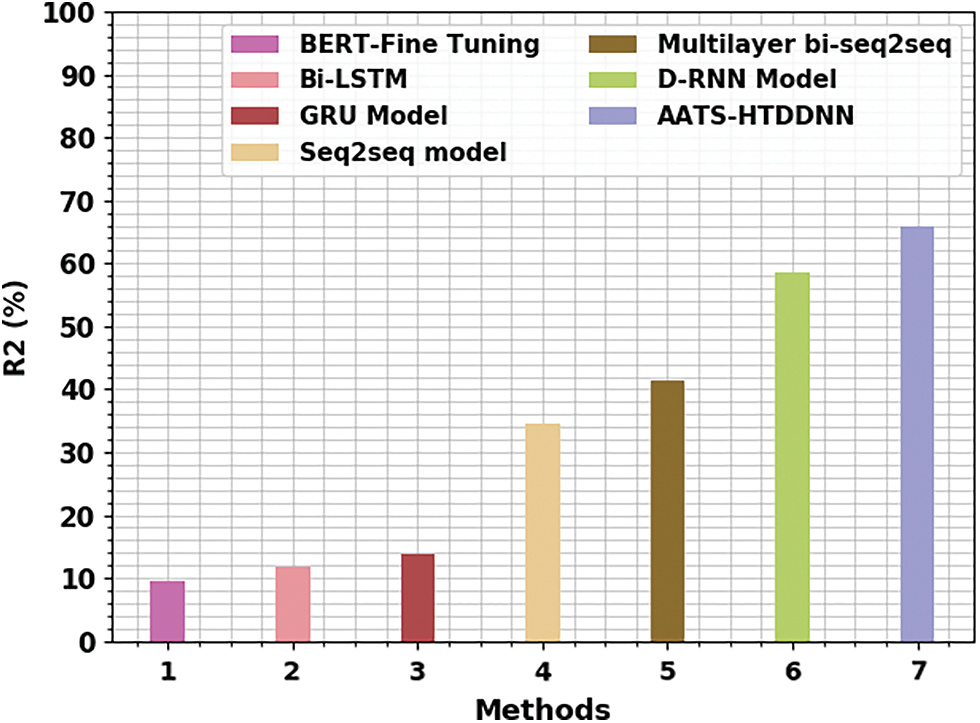
Figure 4: R2 analysis results of AATS-HTDDNN approach and other existing algorithms
Fig. 5 illustrates the detailed RL analysis results achieved by the proposed AATS-HTDDNN approach and other existing models in terms of RL. The results infer that BERT-Fine Tuning and BiLSTM techniques reported the least RL values, such as 13.24% and 20.70% correspondingly. In parallel, GRU, Seq2seq, and multilayer bi-seq2seq techniques displayed slightly increased RL values, such as 38.92%, 44.23%, and 50.08% correspondingly. Temporarily, D-RNN approach gained a reasonable RL value of 70.10%. But, the proposed AATS-HTDDNN technique achieved an enhanced performance with a maximal RL value of 77.31%.
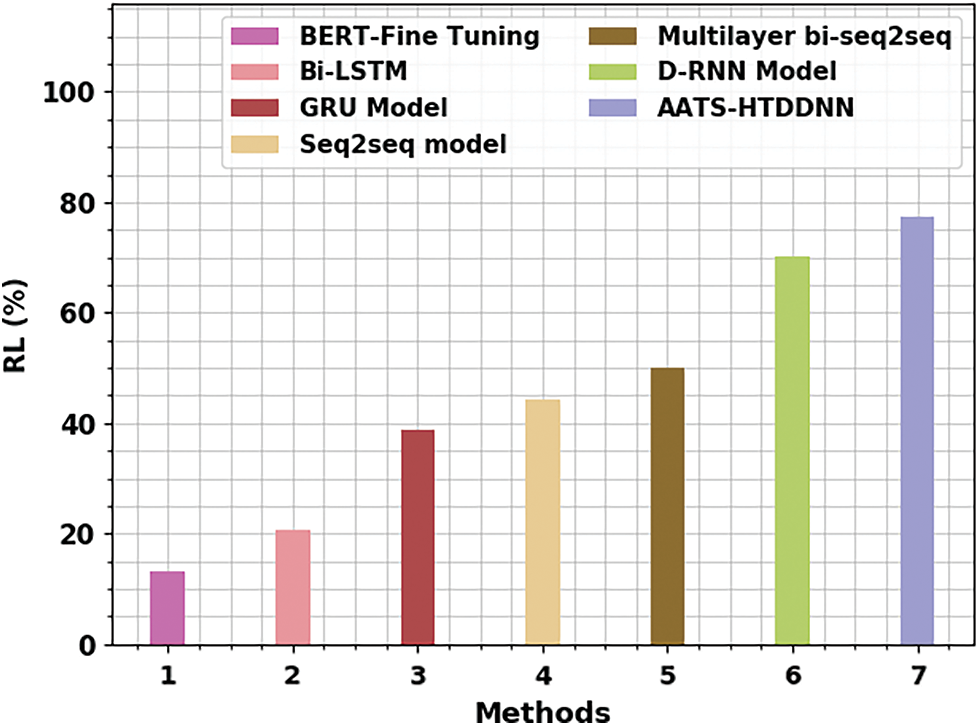
Figure 5: RL analysis results of AATS-HTDDNN approach and other existing algorithms
Table 2 shows the detailed summarization outcomes achieved by the proposed AATS-HTDDNN and other existing models on 27-topic labelled dataset. Fig. 6 portrays the comparative

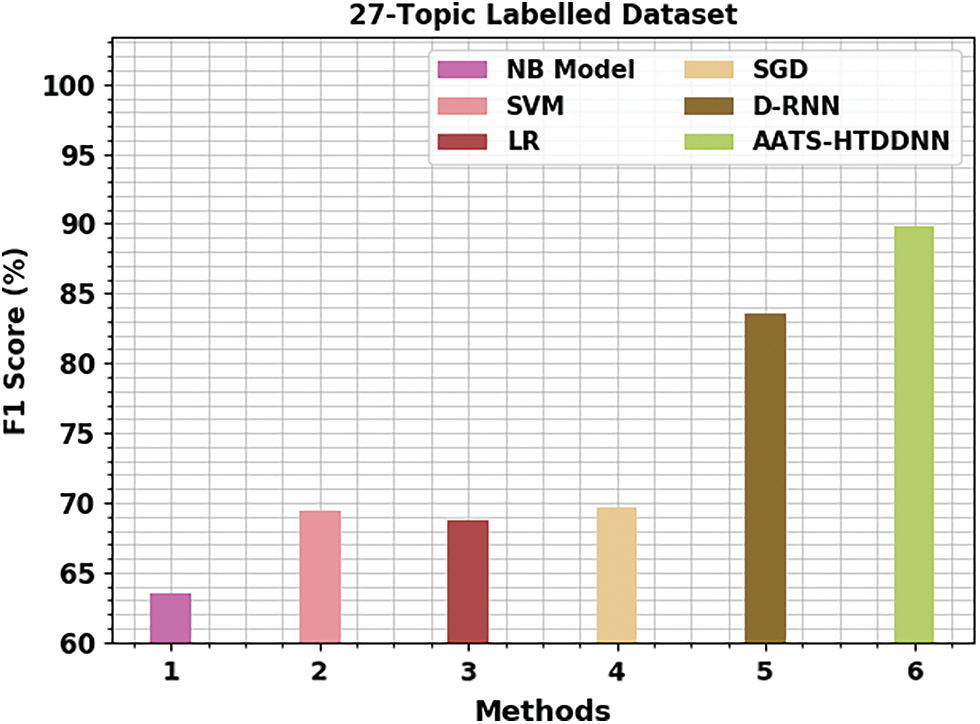
Figure 6:
Fig. 7 portrays the brief
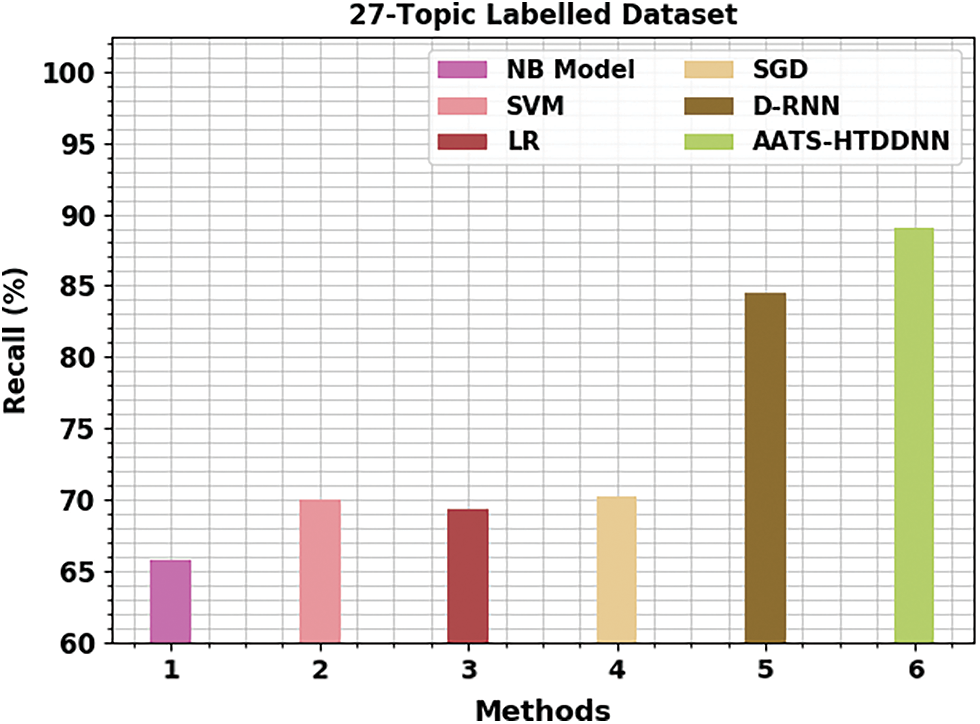
Figure 7:
Fig. 8 validates the comprehensive
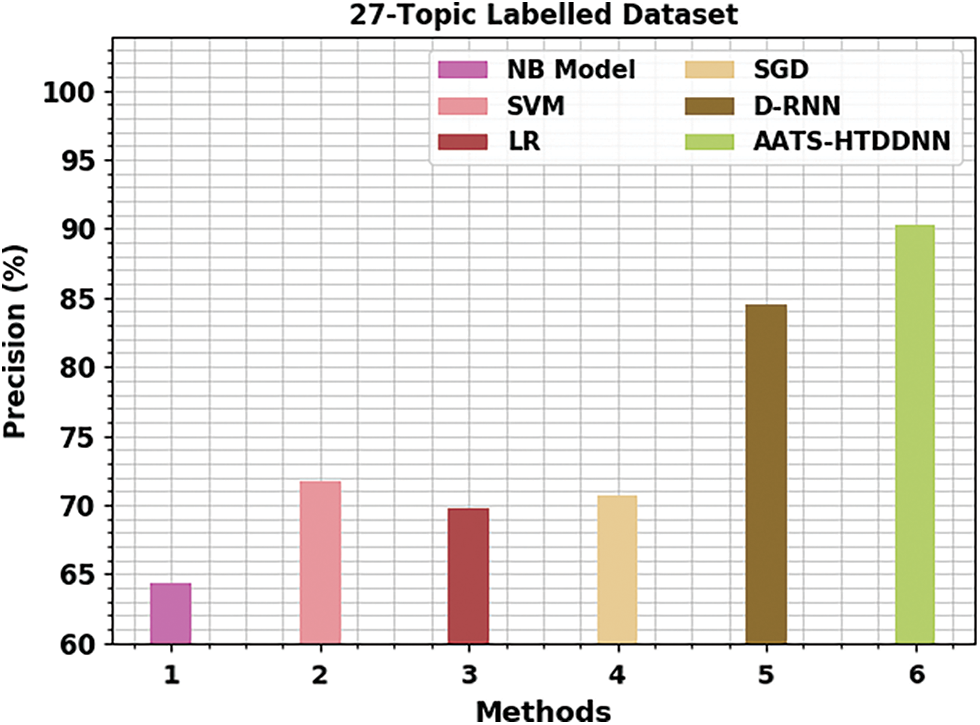
Figure 8:
Both Training Loss (TRL) and Validation Loss (VLL) values, attained by the proposed AATS-HTDDNN algorithm on 27-topic labelled dataset, are shown in Fig. 9. The experimental outcomes imply that the AATS-HTDDNN methodology established the least TRL and VLL values while VLL values were lesser than TRL.

Figure 9: TRL and VLL analyses results of AATS-HTDDNN approach on 27-topic labelled dataset
Table 3 shows the thorough summarization outcomes, yielded by the proposed AATS-HTDDNN and other existing techniques in terms of ROUGE. Fig. 10 shows the brief

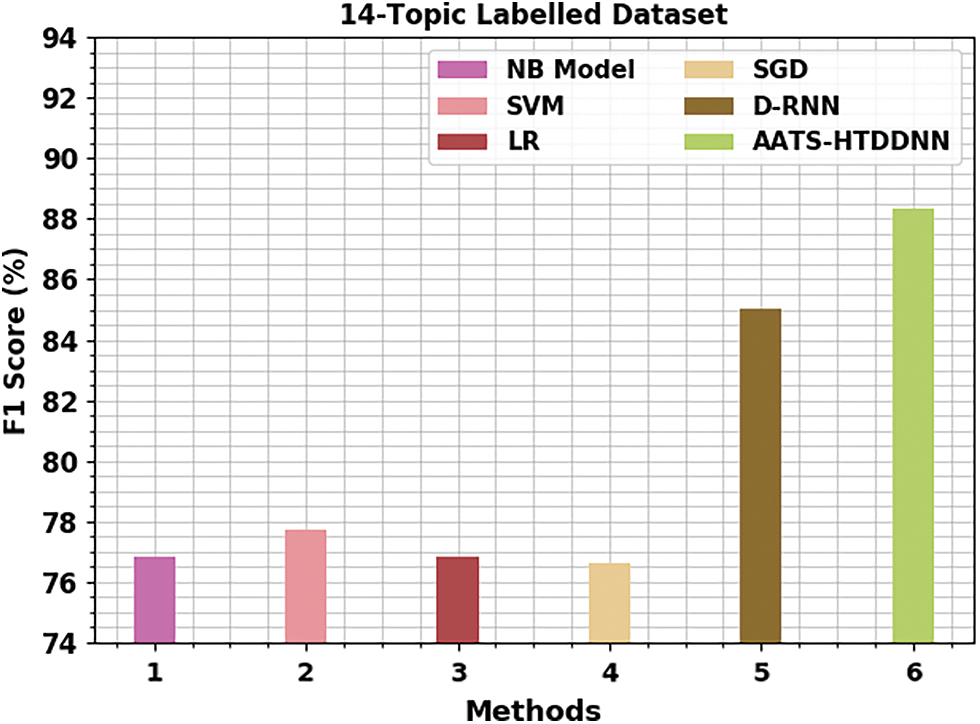
Figure 10:
Fig. 11 portrays the comparative
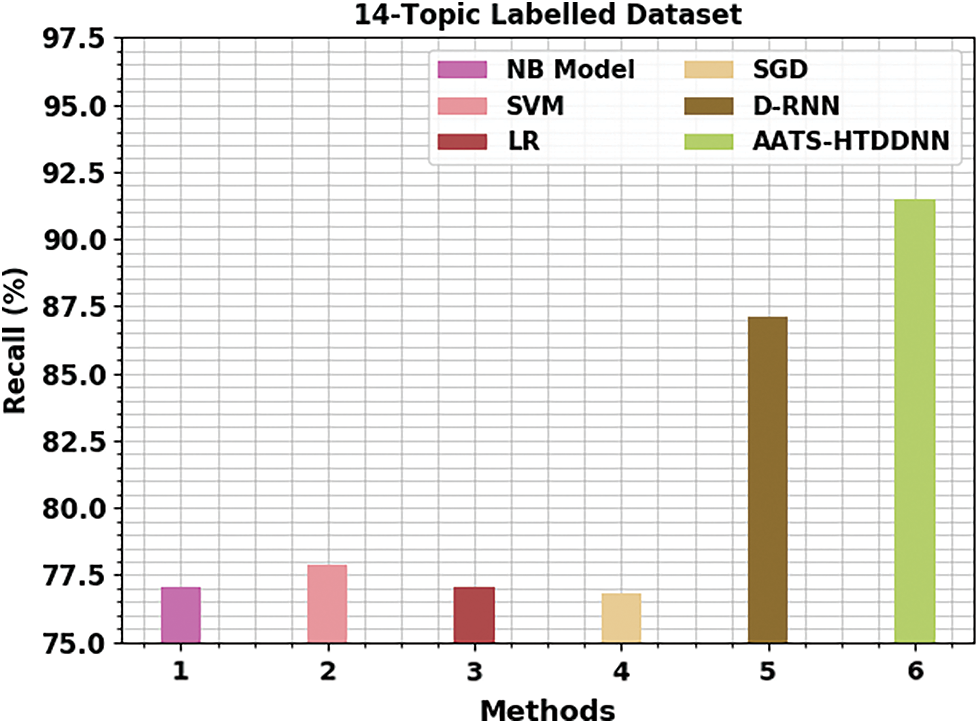
Figure 11:
Fig. 12 demonstrates the comparative
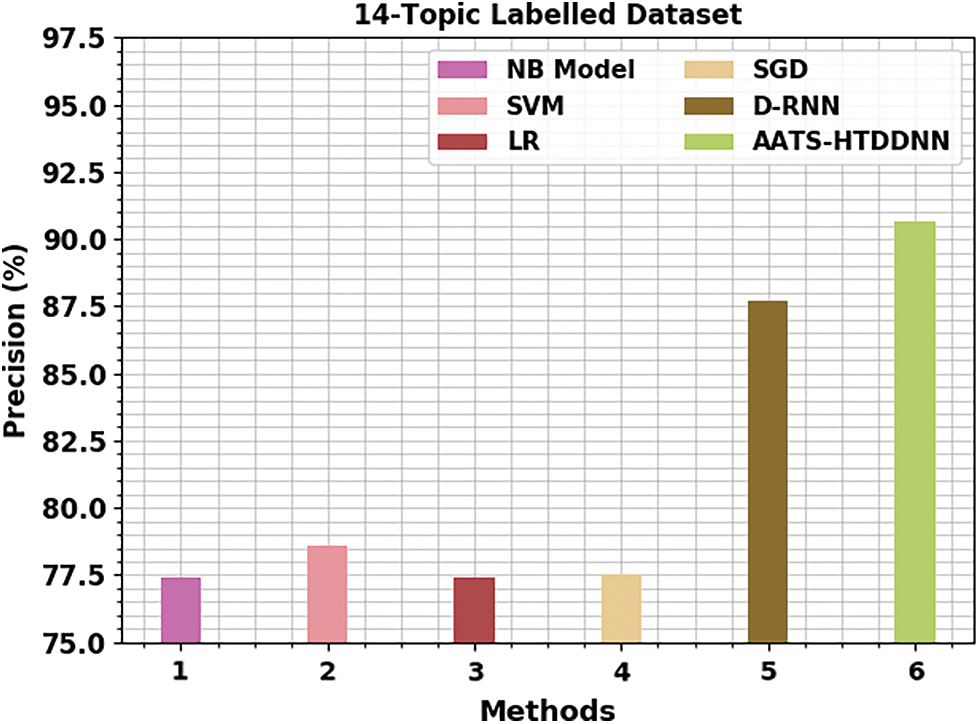
Figure 12:
Both TRL and VLL values, attained by the proposed AATS-HTDDNN technique on 14-topic labelled dataset, are shown in Fig. 13. The experimental outcomes denote that AATS-HTDDNN method established the least TRL and VLL values while VLL values were lesser than TRL.
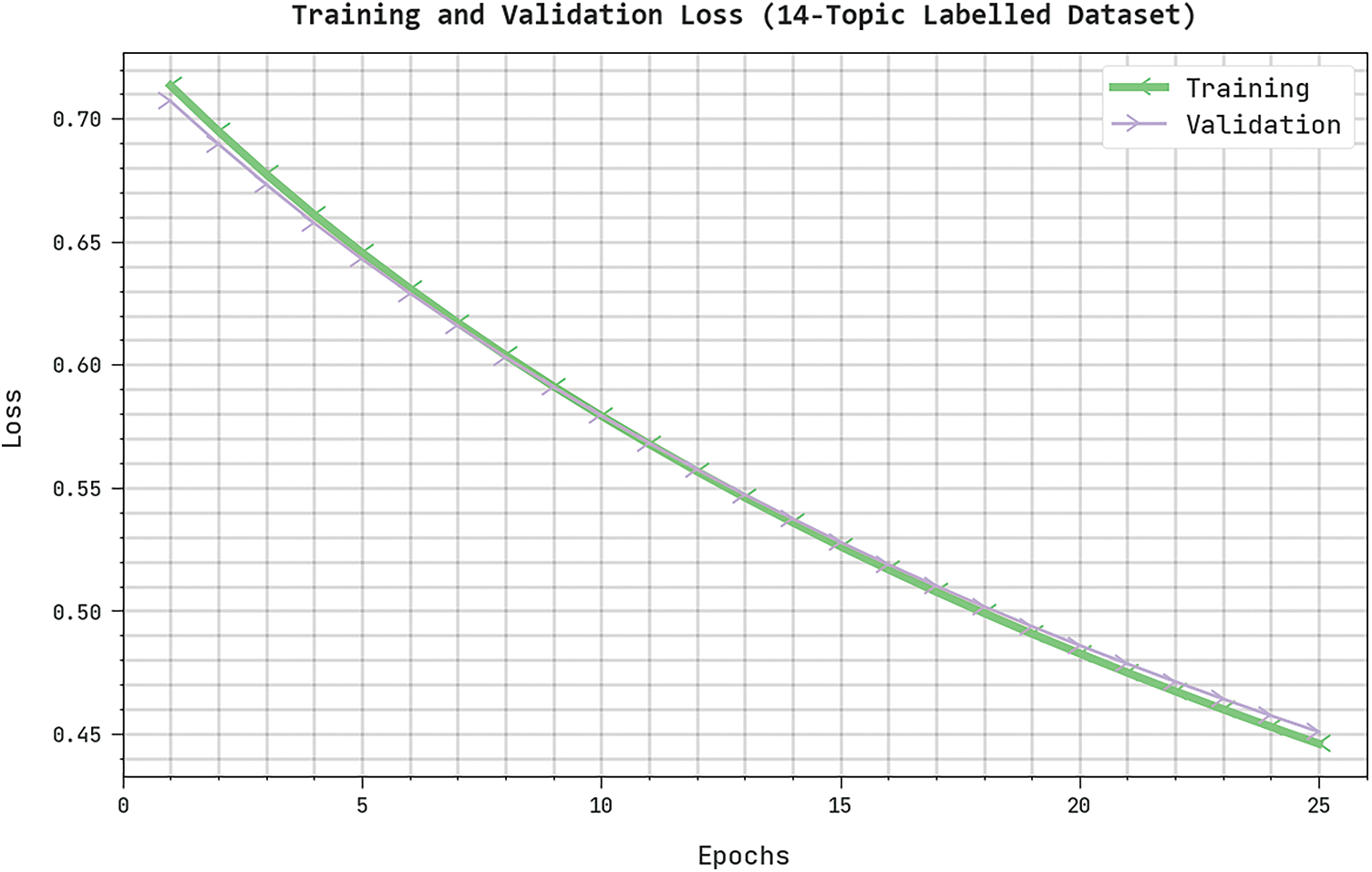
Figure 13: TRL and VLL analyses results of AATS-HTDDNN approach on 14-topic labelled dataset
The results and the discussion made above confirmed the enhanced performance of AATS-HTDDNN model over other existing models.
In the current study, the proposed AATS-HTDDNN technique has been developed for Arabic text summarization. The aim of the presented AATS-HTDDNN technique is to generate summaries of Arabic text. In the presented AATS-HTDDNN technique, the DDNN model is utilized for the generation of summaries. Since the hyperparameters, relevant to the DDNN model, considerably affect the efficiency of the summarization process, the CSO algorithm is exploited. To validate the enhanced summarization performance of the proposed AATS-HTDDNN model, a comprehensive experimental analysis was conducted. The comparison study outcomes established the superior performance of the AATS-HTDDNN model over other approaches. In the future, the performance of the AATS-HTDDNN algorithm can be boosted with the incorporation of hybrid metaheuristics-based hyperparameter tuning algorithms.
Acknowledgement: The authors express their gratitude to Princess Nourah bint Abdulrahman University researchers supporting the project.
Funding Statement: Princess Nourah bint Abdulrahman University Researchers Supporting Project Number (PNURSP2022R281), Princess Nourah bint Abdulrahman University, Riyadh, Saudi Arabia. The authors would like to thank the Deanship of Scientific Research at Umm Al-Qura University for supporting this work by Grant Code: 22UQU4210118DSR33. The authors are thankful to the Deanship of Scientific Research at Najran University for funding this work under the Research Groups Funding Program Grant Code (NU/RG/SERC/11/7).
Author Contributions: Conceptualization, Hala J. Alshahrani; Methodology, Hala J. Alshahrani; Ibrahim M. Alwayle, Saud S. Alotaibi. Software, Khaled M. Alalayah; Validation, Amira Sayed A. Aziz; Investigation, Khadija M. Alaidarous; Data curation, Ibrahim Abdulrab Ahmed; Writing–original draft, Ibrahim M. Alwayle, Hala J. Alshahrani, Saud S. Alotaibi, Khaled M. Alalayah, Manar Ahmed Hamza; Writing–review & editing, Manar Ahmed Hamza, Khadija M. Alaidarous, Ibrahim Abdulrab Ahmed; Visualization, Amira Sayed A. Azi; Project administration, Manar Ahmed Hamza; Funding acquisition, Hala J. Alshahrani. All authors have read and agreed to the published version of the manuscript.
Availability of Data and Materials: Data sharing not applicable to this article as no datasets were generated during the current study.
Conflicts of Interest: The authors declare that they have no conflicts of interest to report regarding the present study.
References
1. M. Al-Maleh and S. Desouki, “Correction to: Arabic text summarization using deep learning approach,” Journal of Big Data, vol. 8, no. 1, pp. 56, 2021. [Google Scholar]
2. B. Elayeb, A. Chouigui, M. Bounhas and O. B. Khiroun, “Automatic arabic text summarization using analogical proportions,” Cognitive Computation, vol. 12, no. 5, pp. 1043–1069, 2020. [Google Scholar]
3. R. Elbarougy, G. Behery and A. El Khatib, “Extractive arabic text summarization using modified pagerank algorithm,” Egyptian Informatics Journal, vol. 21, no. 2, pp. 73–81, 2020. [Google Scholar]
4. F. N. Al-Wesabi, “A smart English text zero-watermarking approach based on third-level order and word mechanism of markov model,” Computers, Materials & Continua, vol. 65, no. 2, pp. 1137–1156, 2020. [Google Scholar]
5. A. H. Ababneh, “Investigating the relevance of Arabic text classification datasets based on supervised learning,” Journal of Electronic Science and Technology, vol. 20, no. 2, pp. 100160, 2022. [Google Scholar]
6. F. N. Al-Wesabi, “Proposing high-smart approach for content authentication and tampering detection of arabic text transmitted via internet,” IEICE Transactions on Information and Systems, vol. E103.D, no. 10, pp. 2104–2112, 2020. [Google Scholar]
7. A. Chouigui, O. B. Khiroun and B. Elayeb, “An Arabic multi-source news corpus: Experimenting on single-document extractive summarization,” Arabian Journal for Science and Engineering, vol. 46, no. 4, pp. 3925–3938, 2021. [Google Scholar]
8. F. N. Al-Wesabi, “A hybrid intelligent approach for content authentication and tampering detection of Arabic text transmitted via internet,” Computers, Materials & Continua, vol. 66, no. 1, pp. 195–211, 2021. [Google Scholar]
9. S. L. M. Sainte and N. Alalyani, “Firefly algorithm based feature selection for Arabic text classification,” Journal of King Saud University–Computer and Information Sciences, vol. 32, no. 3, pp. 320–328, 2020. [Google Scholar]
10. Q. A. Al-Radaideh and M. A. Al-Abrat, “An Arabic text categorization approach using term weighting and multiple reducts,” Soft Computing, vol. 23, no. 14, pp. 5849–5863, 2019. [Google Scholar]
11. F. N. Al-Wesabi, “Entropy-based watermarking approach for sensitive tamper detection of Arabic text,” Computers, Materials & Continua, vol. 67, no. 3, pp. 3635–3648, 2021. [Google Scholar]
12. K. A. Maria, K. M. Jaber and M. N. Ibrahim, “A new model for Arabic multi-document text summarization,” International Journal of Innovative Computing, Information and Control, vol. 14, no. 4, pp. 1443–1452, 2018. [Google Scholar]
13. S. S. Mohamed and S. Hariharan, “A performance study of text summarization model using heterogeneous data sources,” International Journal of Pure and Applied Mathematics, vol. 119, no. 16, pp. 2001–2007, 2018. [Google Scholar]
14. Y. Kumar, K. Kaur and S. Kaur, “Study of automatic text summarization approaches in different languages,” Artificial Intelligence Review, vol. 54, no. 8, pp. 5897–5929, 2021. [Google Scholar]
15. Q. A. Al-Radaideh and D. Q. Bataineh, “A hybrid approach for Arabic text summarization using domain knowledge and genetic algorithms,” Cognitive Computation, vol. 10, no. 4, pp. 651–669, 2018. [Google Scholar]
16. A. Qaroush, I. A. Farha, W. Ghanem, M. Washaha and E. Maali, “An efficient single document Arabic text summarization using a combination of statistical and semantic features,” Journal of King Saud University–Computer and Information Sciences, vol. 33, no. 6, pp. 677–692, 2019. [Google Scholar]
17. N. Alami, M. Mallahi, H. Amakdouf and H. Qjidaa, “Hybrid method for text summarization based on statistical and semantic treatment,” Multimedia Tools and Applications, vol. 80, no. 13, pp. 19567–19600, 2021. [Google Scholar]
18. N. Alami, M. Meknassi, N. En-Nahnahi, Y. El Adlouni and O. Ammor, “Unsupervised neural networks for automatic Arabic text summarization using document clustering and topic modeling,” Expert Systems with Applications, vol. 172, pp. 114652, 2021. [Google Scholar]
19. K. Al-Sabahi, Z. Zhang, J. Long and K. Alwesabi, “An enhanced latent semantic analysis approach for Arabic document summarization,” Arabian Journal for Science and Engineering, vol. 43, no. 12, pp. 8079–8094, 2018. [Google Scholar]
20. N. Alami, N. En-Nahnahi, S. A. Ouatik and M. Meknassi, “Using unsupervised deep learning for automatic summarization of Arabic documents,” Arabian Journal for Science and Engineering, vol. 43, no. 12, pp. 7803–7815, 2018. [Google Scholar]
21. S. Abdulateef, N. A. Khan, B. Chen and X. Shang, “Multidocument Arabic text summarization based on clustering and word2vec to reduce redundancy,” Information, vol. 11, no. 2, pp. 59, 2020. [Google Scholar]
22. J. L. Vincent, R. Manzorro, S. Mohan, B. Tang, D. Y. Sheth et al., “Developing and evaluating deep neural network-based denoising for nanoparticle tem images with ultra-low signal-to-noise,” Microscopy and Microanalysis, vol. 27, no. 6, pp. 1431–1447, 2021. [Google Scholar]
23. M. Said, A. M. El-Rifaie, M. A. Tolba, E. H. Houssein and S. Deb, “An efficient chameleon swarm algorithm for economic load dispatch problem,” Mathematics, vol. 9, no. 21, pp. 2770, 2021. [Google Scholar]
Cite This Article
 Copyright © 2023 The Author(s). Published by Tech Science Press.
Copyright © 2023 The Author(s). Published by Tech Science Press.This work is licensed under a Creative Commons Attribution 4.0 International License , which permits unrestricted use, distribution, and reproduction in any medium, provided the original work is properly cited.


 Submit a Paper
Submit a Paper Propose a Special lssue
Propose a Special lssue View Full Text
View Full Text Download PDF
Download PDF Downloads
Downloads
 Citation Tools
Citation Tools